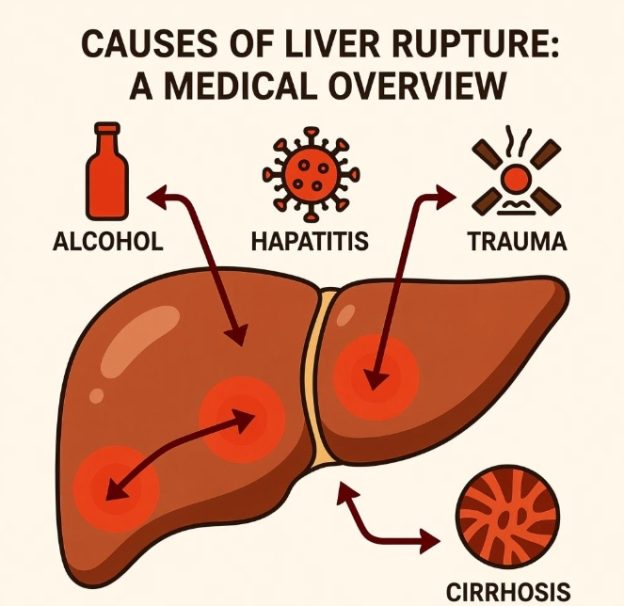Hepatic rupture is an acute disruption of liver parenchyma that may follow blunt trauma, penetrating injury, spontaneous bleeding from tumours, or iatrogenic insults during percutaneous procedures. Clinical expression ranges from contained subcapsular haematoma to massive intraperitoneal haemorrhage and haemodynamic collapse. Recognition of the constellation below is essential for rapid intervention.
- Acute abdominal pain
Sudden, severe right-upper-quadrain pain often radiates to the shoulder tip (phrenic nerve irritation) and is exacerbated by movement, coughing, or deep inspiration. - Peritoneal irritation
Blood and bile extravasate onto the peritoneal surface, producing guarding, rebound tenderness and board-like rigidity. Shoulder-tip pain may dominate when the patient is supine. - Hypovolaemic shock
Tachycardia > 120 beats min⁻¹, hypotension, narrowed pulse pressure, cool clammy extremities, and altered sensorium indicate > 30 % circulating volume loss. Paradoxical bradycardia can transiently occur with high spinal reflexes. - Abdominal distension and shifting dullness
Rapid accumulation of blood creates a tensely distended abdomen with positive fluid thrill and dullness that shifts to the flanks. - Falling haematocrit and haemoglobin
Serial measurements show a progressive drop within 30–60 min despite crystalloid resuscitation; base deficit and lactate rise in parallel. - Nausea, vomiting and vasovagal response
Vagal stimulation from peritoneal irritation or hypotension leads to repeated retching, sweating and transient hypotension. - Associated thoracic signs
Right-sided pleural rub or basal crackles suggest concomitant diaphragmatic injury or pleural effusion from peritoneal blood tracking. - Localised swelling and ecchymosis
Subcapsular haematoma may present as a tender, palpable hepatic mass without free intraperitoneal blood; overlying bruising or seat-belt imprint implies deceleration injury. - Coagulopathy and haemobilia
Massive transfusion or underlying cirrhosis can precipitate diffuse oozing; communication with bile ducts produces intermittent haematemesis and melaena (haemobilia).
| Symptom / Sign | Typical Presentation |
|---|---|
| Acute RUQ pain | Sudden, severe, radiates to shoulder |
| Peritoneal signs | Guarding, rebound, board-like rigidity |
| Hypovolaemic shock | Tachycardia, hypotension, cool skin |
| Abdominal distension | Positive shifting dullness, fluid thrill |
| Falling Hb/Hct | Progressive despite resuscitation |
| Nausea/vomiting | Vagal response to irritation |
| Pleural signs | Rub, crackles, effusion |
| Localised mass | Tender hepatomegaly (subcapsular) |
| Haemobilia | Intermittent GI bleeding, melaena |
